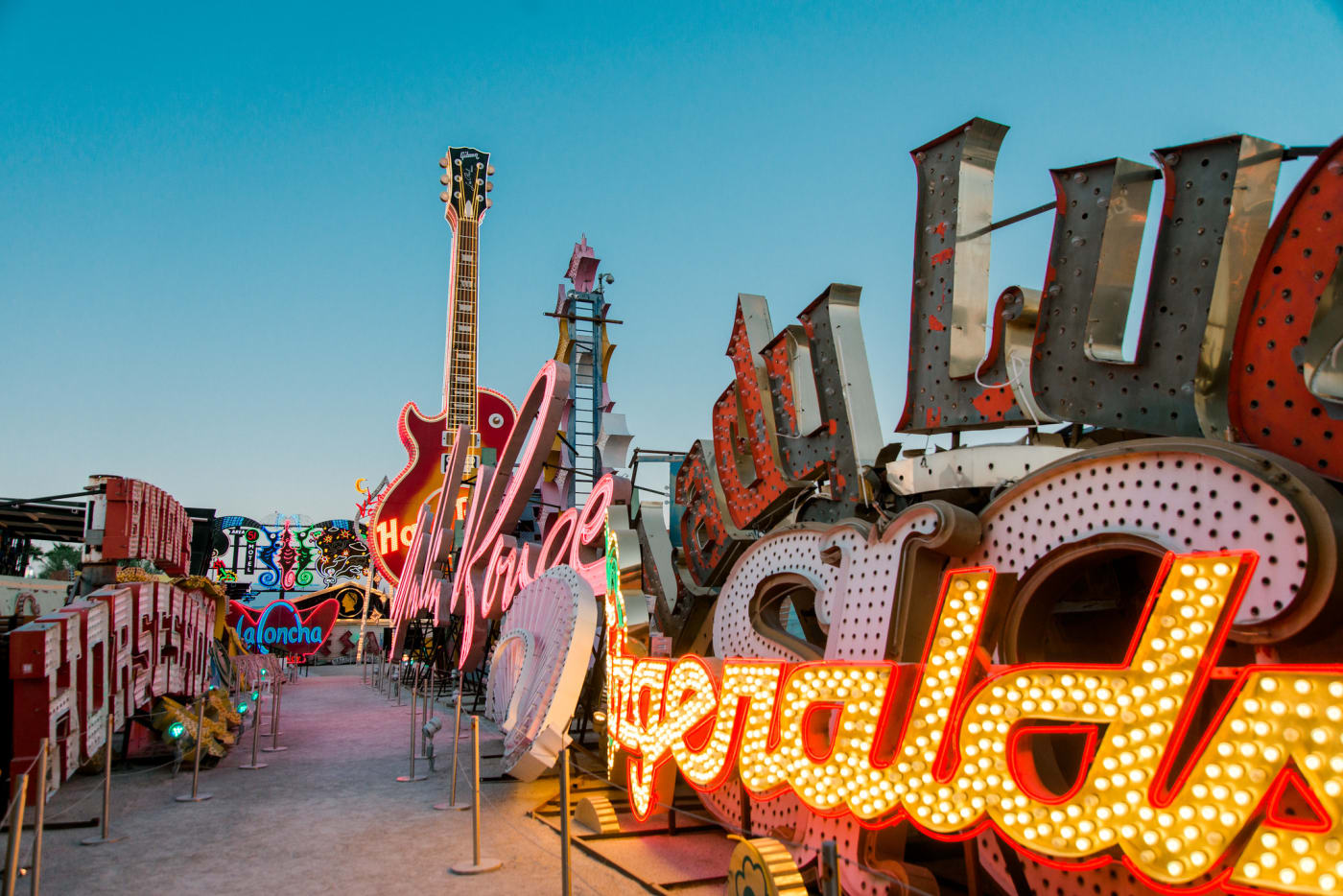THE MINT

Dell Webb’s Mint, February 1988, Anita Roseberg Collection, Neon Museum, 1988

The Mint tower construction, 1965, UNLV Digital Collections

The Mint, 1957, UNLV Digital Collections
In 1957, architects Walter Zick and Harris Sharp teamed with YESCO sign designers Hermon Boernge and Kermit Wayne to create a groundbreaking sign for the new downtown Mint Hotel. They seamlessly fused a horizontal “eyebrow” with a soaring 85-foot blade sign.
In 1959, YESCO produced “The Mint: Birth of a Giant,” a two-part documentary that followed the development of the display from initial design to final installation. The sign was replaced when the Mint was purchased by Binion’s Horseshoe in 1988, although it is still possible to glimpse a small section of it today.
THE DUNES

UNLV Digital Collections, Culinary Workers Union Local 226 collection, 1950s-1960s

The Dunes Entrance sign before restoration.
The Dunes was home to several signs that met tragic ends.
The smiling Dunes Sultan, a towering fiberglass statue created by YESCO, greeted guests from the roof of the hotel when it opened in 1955. In 1964, the Sultan relocated to the golf course, where he served as a highway sign along I-15. He was destroyed by fire in the late 1980s.
The Dunes pylon sign was designed by Lee Klay for Federal Sign in 1964 and won that year’s General Electric trophy for neon sign design. Standing 180 feet tall, it was the largest electric sign in the world. The pylon’s height required maintenance workers to use a small elevator tucked inside one of the support legs to reach the top.
The sign was destroyed in 1993 as part of a spectacular implosion that leveled the Dunes to make way for the Bellagio. A smaller, similarly shaped Dunes sign can be seen at The Neon Museum.
THE SANDS

Slide of the Sands Hotel sign, Las Vegas, circa 1950s-1960s, UNLV Digital Collections

Courtesy Las Vegas Review Journal
In 1952, the Sands Hotel set a new standard for sign size and design along the Las Vegas Strip. As much architecture as it was signage, the 56-foot-tall display featured the hotel name in script neon letters against a rectangular grid, all dramatically cantilevered from a single pylon. The design has been attributed alternatively to architect Wayne McAllister and YESCO sign designer Hermon Boernge. Frank Sinatra and other members of the “Rat Pack” famously posed for photographs in front of the sign.
The original was replaced during new construction in the 1960s. The Sands sign was one of the inspirations for the Neon Boneyard Park sign on The Neon Museum campus, which was designed by Brian “Buzz” Leming.
The Thunderbird

Thunderbird Hotel signage, 1948, UNLV Digital Collections

Thunderbird Hotel, circa 1960s, UNLV Digital Collections
The Thunderbird opened in 1948 as the fourth resort on the Las Vegas Strip. Graham Neon Sign Company created two stylized neon birds for the Western/Native American themed property.
In the 1960s, the exterior of the hotel was remodeled and one of the birds was incorporated into a new marquee pylon sign designed by Bill Clarke of AD-ART. The last of the birds departed in 1977 when Major Riddle rebranded the hotel as the Silverbird.
From 1982 to 1992, the property was called the El Rancho (not to be confused with the original El Rancho which operated at a different Strip location from 1941 to 1960). Today, it is the proposed site of the Drew Las Vegas. A smaller replica of the 1948 neon bird sign now adorns the new Thunderbird Hotel, a boutique property located north of the Strip.

Lost Signs of Las Vegas—Part 2
- Las Vegas History
- Las Vegas Strip
- Off Strip

The History of the Horseshoe: Binion’s Role in Shaping Downtown Vegas
- Downtown Las Vegas
- Las Vegas History

Las Vegas Wedding Chapels and Their Flashy Signs
- Las Vegas History
- Our Spaces

